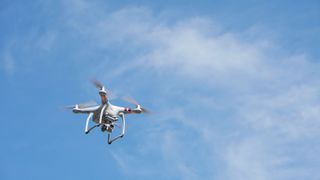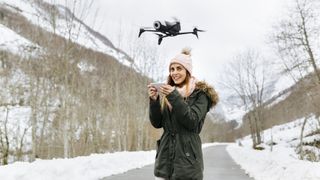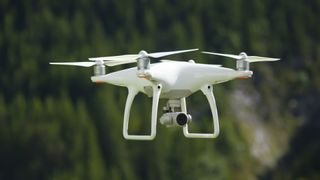Drone Regulations: Everything you need to know
We tell you everything you need to know about drone regulations and flying legally.

It’s an exciting moment when you unbox a shiny new drone, and of course the first thing you want to do is get it up in the air. But before you start flying and capturing stunning aerial footage, you need to make sure you’re abiding by the rules and regulations set by the Federal Aviation Administration (FAA). Below are answers to the most common questions asked when it comes to flying a drone safely and legally.
Do you need a qualification to fly a drone?
If you’re simply using your drone for recreational use, then no. For those looking to make some money with stunning aerial footage, you’ll need to fly under Part 107 guidelines - which involves taking a test to become a certified drone pilot.
For those just wanting to have fun flying around and capturing photos and videos to show your friends, you can do so without taking any rigorous tests but you’ll still need to take a few steps before taking to the skies.
Do you need to register your drone?
Everyone needs to register their drone, whether you’re flying recreationally or for commercial use. The only exception is if your drone weighs less than 250 grams. Most drones on the market weigh more than 250 grams but there are some lighter aircraft out there, such as the Sanrock U52 and 4DRC F10 drones.
To register your drone, you need to come prepared with the following details: personal information (home address, email address, phone number), the make and model of your drone, and a credit or debit card. Registration costs $5 but that will cover you for the next three years. The only requirements for registering is that you need to be thirteen years or older and a U.S citizen or legal resident.

Once your drone is registered, you’ll receive a FAA registration certificate. You’ll need this certificate on hand with you every time you fly, and you’re required to show it to any Federal, State, or local law enforcement officer if asked. You’ll also receive a registration number which needs to be clearly marked on the exterior of your drone. Engraving and permanent marker is acceptable but the best thing to do is to use printable stickers or a label maker. You can register your drone over at DroneZone.
What rules do I need to follow when flying a drone?
To help familiarise yourself with the rules, it’s best to take the TRUST test. One of the rules is to complete this free test and have the certificate of completion on hand when flying, but the test itself serves as a great way to learn the general rules for flying drones. A lot of it is common sense: don’t fly under the influence, keep your drone in sight at all times, don’t fly over crowds and keep out of the way of manned aircraft i.e. airplanes. Thankfully the test will only take half an hour of your time and it’s impossible to fail as you can relearn and take the test as many times as you need to.
You do, however, need to understand the differences between controlled and uncontrolled airspace and the rules that apply to flying in each area. Recreational flyers cannot fly in controlled airspace, which are usually areas near military bases, stadiums, airports and well-populated areas. You can fly freely in uncontrolled airspace but of course you still need to follow the general guidelines. To help identify what is deemed as controlled or uncontrolled airspace, you can use the B4UFLY app. It’s FAA approved and features interactive maps that can tell you whether the area you’re in is safe to fly your drone. Other restricted areas within the country to take note of are National Parks and Washington D.C.

When it comes to flying at night, there aren’t any official rules for recreational flyers. Commercial drone pilots are allowed to fly at night but only after they have taken an additional test and have installed anti-collision lights onto their drone. It’s recommended that recreational flyers install lights on their drones too when flying at night, like this Strobe Anti-Collision Drone Light for example. If anything it’s to benefit you as much as other aircraft in the night sky as you’ll be able to better keep an eye on your drone when it’s off in the distance.
Other rules to take note of are that you can’t fly a drone that weighs more than 55lbs (that includes any packages or additional items attached to the drone), you must fly at or under 400ft even in uncontrolled airspace, and pilots operating a drone through a First Person View (using VR headsets) must have a visual observer beside them to keep the drone itself in their line of sight.
Do drone regulations differ across different states?
The general rules explained previously apply to flying your drone no matter what state you’re in. Drones are quite new in the grand scheme of things, so different states are still enacting new laws and legislations as time goes on. None of these should affect you, unless you plan on delivering medical majurana in New Jersey or are wanting to equip your drone with deadly payloads in Kentucky. You can find up to date state laws and bills for drones here.
Anything else worth knowing?
The FAA has just introduced a new rule coming into effect from September 23rd 2023. All drones will be required from that date to have Remote ID, which will notify authorities and other parties of your drone’s identification and location details whilst in flight. The 2023 deadline is to give manufacturers, such as DJI, time to implement this new feature into their drones. The FAA is proposing a plan to make Remote ID broadcast modules available, so you can simply attach it to your current drone without having to buy a new one that has Remote ID natively built-in.
If you stick to the rules and guidelines, you’ll be sure to have a lot of fun flying your drone without causing any trouble. Use common sense and don’t go flying near airports or over your neighbour’s garden. Think about the time of day when flying too: go out during sunrise or sunset when there are less people about and you’re able to capture footage of gloriously golden environments. It’ll make things safer for you and your drone, and you’ll have some incredible images to show off to your friends too.
Join our Space Forums to keep talking space on the latest missions, night sky and more! And if you have a news tip, correction or comment, let us know at: community@space.com.
Get the Space.com Newsletter
Breaking space news, the latest updates on rocket launches, skywatching events and more!
Gavin is a Freelance Writer and Gaming Editor for Filmhounds Magazine. With a particular interest in film, TV and gaming, his work can be found within outlets such as Flip Screen, New Game+ and JumpCut PLAY. On top of that, Gavin is an aspiring screenwriter and is currently taking part in a Games Writing Mentorship based in East Anglia. If he’s not writing about queer people in horror stories, he’ll be writing about sad people facing existential dilemmas in space.
